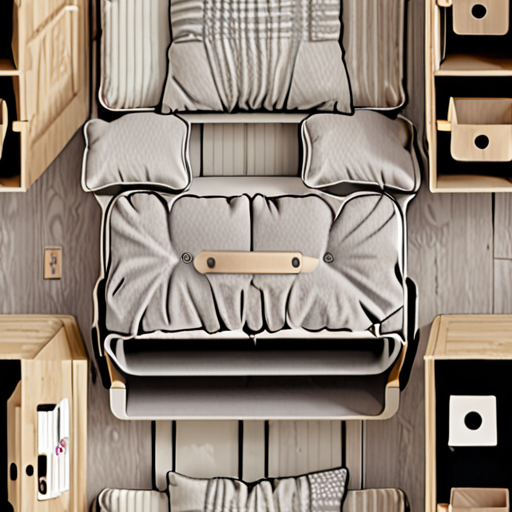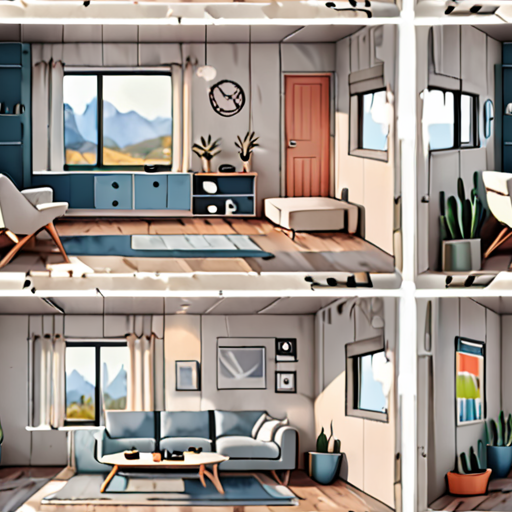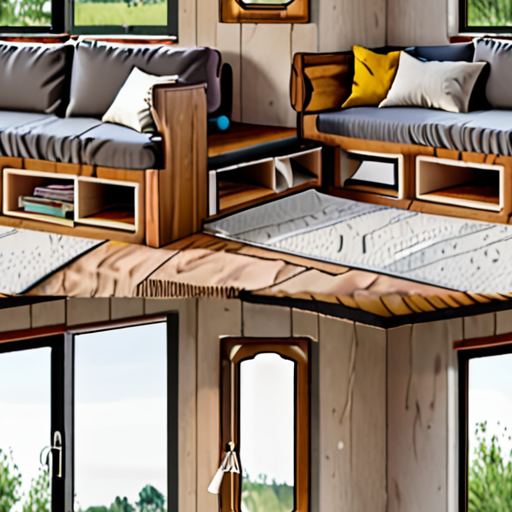As people increasingly opt for smaller living spaces, whether it’s due to financial constraints, environmental concerns, or simply a desire for a more minimalist lifestyle, the need for innovative and practical solutions has never been greater. This is where multifunctional furniture comes in – cleverly designed pieces that serve multiple purposes, making the most of limited space while providing comfort, functionality, and style. From compact kitchens to cozy bedrooms, multifunctional furniture offers a wide range of benefits, including increased storage capacity, reduced clutter, and enhanced versatility.

What is Multifunctional Furniture Called?
Multifunctional furniture refers to pieces that serve more than one purpose, often designed to save space and increase functionality.
- Transformable furniture
- Convertible furniture
- Spacesaving furniture
This type of furniture is typically made using unique design and technology to achieve the intended use.
Types of Multifunctional Furniture
- Sofa beds
- Storage ottomans
- Desks with built-in shelving
These versatile pieces can be found in various styles and designs, from modern to traditional, making them suitable for different tastes and decor.
Benefits of Multifunctional Furniture
- Saves space
- Increases functionality
- Reduces clutter
By incorporating multifunctional furniture into your home, you can create a more efficient and organized living space that meets your needs.
Designing with Multifunctional Furniture
To get the most out of multifunctional furniture, consider the following tips:
- Measure your space carefully before purchasing
- Choose pieces that fit your lifestyle and needs
- Experiment with different configurations and arrangements
With a little creativity and planning, you can unlock the full potential of multifunctional furniture and create a harmonious and functional living space.
Difference Between Multifunctional and Multipurpose
We often come across these two terms – multifunctional and multipurpose – which seem to convey similar meanings, but there’s a subtle distinction between them.
-
Multifunctional:
A product or item is considered multifunctional if it has been specifically designed to perform multiple functions or tasks beyond its primary purpose.
- Example: A smartphone is a multifunctional device as it allows users to make phone calls, send texts, browse the internet, take photos, and play games.
- Another example would be a Swiss Army knife, which is designed to perform various tasks such as cutting, opening cans, and even serving as a screwdriver.
-
Multipurpose:
An object or tool is considered multipurpose if it can be used for tasks other than what it was originally intended for, but it wasn’t necessarily designed to do so.
- Example: A raincoat can be used as a picnic blanket, making it a multipurpose item.
- Another example would be using a towel as a beach mat or a tablecloth.
In essence, multifunctional items are designed to perform multiple tasks, whereas multipurpose items can be repurposed for tasks other than their original intention.
At Peck and Gartner, we understand the importance of understanding these nuances to make informed decisions when it comes to choosing products that meet our needs.
Whether you’re looking to upgrade your home decor or find innovative solutions for everyday problems, our team is dedicated to providing you with the knowledge and expertise to make the most out of your purchases.
For more information on how to choose the right products for your needs, visit our Home Decor Tips page.
Additionally, check out our DIY Project Ideas page for creative ways to repurpose items and give old objects a new life.
By understanding the difference between multifunctional and multipurpose, you’ll be better equipped to navigate the world of consumer goods and make informed choices that suit your lifestyle.

What is Multifunctional Design?
Multifunctional design refers to the creation of products or spaces that serve multiple purposes, often combining functionality with aesthetics. This approach has gained popularity in recent years due to its ability to optimize space, reduce clutter, and increase efficiency. In the context of furniture, multifunctional pieces can transform a room’s purpose and functionality, making them ideal for small homes, apartments, or shared living spaces.
Examples of Multifunctional Design
Some notable examples of multifunctional design include:
- Sofa beds that convert into guest bedrooms or home offices
- Folding desks that create a workspace when needed
- Storage ottomans that double as seating and storage units
- Murphy beds that fold up against walls to reveal additional floor space
- Modular shelving systems that adapt to changing storage needs
The Benefits of Multifunctional Design
Multifunctional design offers several benefits, including:
- Space-saving solutions for small homes or apartments
- Increased flexibility and adaptability in changing environments
- Reduced clutter and improved organization
- Increased functionality and productivity
- Cost-effective alternatives to purchasing separate items
Real-Life Applications of Multifunctional Design
Peck and Gartner have worked with numerous clients who have successfully incorporated multifunctional design into their homes and offices. By choosing multifunctional pieces, our clients have been able to:
- Create seamless transitions between living and working spaces
- Optimize storage capacity and reduce clutter
- Maximize available floor space
- Enhance overall aesthetic appeal and style
Conclusion
Multifunctional design is a versatile and innovative approach to product and space creation. By embracing multifunctionality, individuals and businesses can reap numerous benefits, from increased efficiency and productivity to reduced clutter and improved aesthetics. At Peck and Gartner, we specialize in helping our clients discover the perfect balance of form and function through expertly crafted multifunctional designs.
The Multifunctional Furniture Market
We’ve been tracking the growth of the multifunctional furniture market, and it’s exciting to see how far it’s come.
- The global multifunctional furniture market size was estimated at $17,810 billion in 2024.
- By 2034, we expect the market to reach $33,345 billion, representing a significant increase from its current state.
Key Players in the Market
As a leading provider of home improvement and interior design solutions, we’re proud to be part of this growing market.
- Houzz is a popular platform for homeowners to discover and share home design and remodeling ideas.
- Wayfair is a leading online retailer of home goods and furniture, offering a vast selection of products to suit various tastes and budgets.
- Crate and Barrel is a well-known destination for stylish and high-quality home furnishings and decor.
Trends Shaping the Market
Several factors are contributing to the growth of the multifunctional furniture market:
- Sustainability : Consumers are increasingly seeking eco-friendly and sustainable options for their homes, driving demand for environmentally responsible furniture.
- Space Efficiency : As urbanization continues to rise, people are looking for ways to maximize their living spaces, making multifunctional furniture a practical solution.
- Technological Advancements : Innovations in materials science and manufacturing processes have enabled the creation of high-quality, durable, and versatile furniture pieces.
Conclusion
With its impressive growth potential and increasing popularity, the multifunctional furniture market presents opportunities for businesses and consumers alike.
Who Dominates the Furniture Market?
The global furniture market is highly competitive, with several major players vying for dominance.
- The United States is currently the largest furniture market in the world, accounting for nearly 30% of global sales.
- China is a close second, with its massive population and rapid economic growth driving demand for furniture.
- The European Union is also a significant player in the global furniture market, with countries like Germany, Italy, and France having well-established furniture industries.
In addition to these major markets, there are many smaller regional players that cater to local tastes and preferences.
Furniture Industry Trends
The global furniture market is expected to continue growing in the coming years, driven by increasing demand for sustainable and eco-friendly products.
- Sustainable materials and production methods are becoming increasingly popular, particularly among younger consumers who prioritize environmental responsibility.
- The rise of e-commerce has also transformed the way people shop for furniture, with online retailers offering greater convenience and flexibility.
- Customization and personalization are also becoming more important, as consumers seek unique and tailored solutions for their homes and workplaces.
Key Players in the Furniture Market
Some of the biggest names in the furniture industry include:
- Herman Miller
- Vitra
- Knoll
- EMU Group
These companies have established themselves as leaders in the industry through their commitment to innovation, quality, and customer satisfaction.
Conclusion
The global furniture market is a complex and dynamic landscape, with numerous players competing for dominance.
By understanding the key trends and players in the industry, consumers can make informed decisions about their furniture purchases and support businesses that share their values and priorities.

What is the Largest Furniture Company in the World?
We’ve got the scoop on the biggest names in the furniture industry.
- IKEA : With its massive global presence and iconic flat-pack designs, IKEA is often considered the largest furniture company in the world.
- Home Depot : As a leading home improvement retailer, Home Depot offers a vast selection of furniture products from various brands, making it a significant player in the market.
- Walmart : Walmart’s extensive network of stores and online platform allows it to offer a broad range of affordable furniture options, solidifying its position as a major furniture retailer.
- Wayfair : As an e-commerce giant specializing in home goods and furniture, Wayfair has become a go-to destination for consumers seeking a vast selection of products at competitive prices.
These companies have revolutionized the furniture industry through innovative designs, efficient supply chains, and customer-centric approaches.
Furniture Industry Trends:
- Sustainable Materials : Many furniture manufacturers are shifting towards eco-friendly materials and production methods to reduce environmental impact.
- Customization : Consumers increasingly demand personalized furniture solutions, driving the growth of bespoke and made-to-order products.
- Digital Shopping Experiences : Online platforms and social media have transformed the way people shop for furniture, with many retailers investing heavily in digital marketing and e-commerce capabilities.
Conclusion:
The largest furniture company in the world is a matter of debate, but one thing is certain – these industry leaders continue to shape the future of furniture retail through innovation, sustainability, and customer satisfaction.

0 Comments